
An icon is a religious work of art, most commonly a painting, in the cultures of the Eastern Orthodox, Oriental Orthodox, and Catholic churches. They are not simply artworks; "an icon is a sacred image used in religious devotion". The most common subjects include Jesus, Mary, saints, and angels. Although especially associated with portrait-style images concentrating on one or two main figures, the term also covers most of the religious images in a variety of artistic media produced by Eastern Christianity, including narrative scenes, usually from the Bible or the lives of saints.
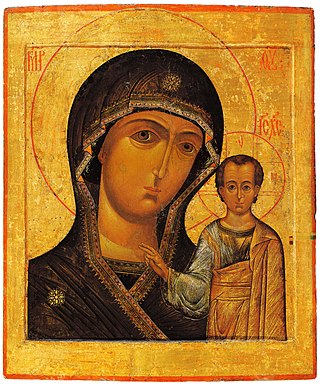
Theotokos is a title of Mary, mother of Jesus, used especially in Eastern Christianity. The usual Latin translations are Dei Genitrix or Deipara. Familiar English translations are "Mother of God" or "God-bearer" – but these both have different literal equivalents in Greek, Μήτηρ Θεοῦ and Θεοφόρος.
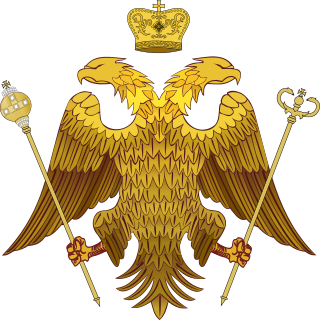
The Church of Cyprus is one of the autocephalous Greek Orthodox churches that together with other Eastern Orthodox churches form the communion of the Eastern Orthodox Church. It is one of the oldest Eastern Orthodox autocephalous churches; it claims to have always been independent, although it may have been subject to the Church of Antioch before its autocephaly was recognized in 431 at the Council of Ephesus. The bishop of the ancient capital, Salamis was constituted metropolitan by Emperor Zeno, with the title archbishop.

A templon is a feature of Byzantine churches consisting of a barrier separating the nave from the sanctuary near the altar.

Stavrovouni Monastery is a Greek Orthodox monastery which stands on the top of a hill called Stavrovouni in Cyprus; it is sometimes simply known as Stavrovouni. The monastery is one of the few places where one can see a piece of the Holy Cross. Stavrovouni Monastery was founded by Saint Helena and Saint Constantine c. AD 327–329.
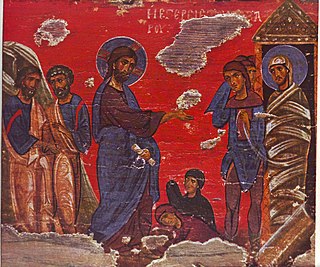
Lazarus of Bethany, also venerated as Righteous Lazarus, the Four-Days Dead in the Eastern Orthodox Church, is the subject of a sign of Jesus in the Gospel of John, in which it is written that Jesus restores Lazarus to life four days after his death. The Eastern Orthodox and Catholic traditions offer varying accounts of the later events of his life.

Agiasos is a small town and a former municipality on the island of Lesbos, North Aegean, Greece. Since the 2019 local government reform, it became a municipality unit that is part of the municipality Mytilene. The municipal unit has an area of 79.924 km2. It is located at the slopes of mount Olympos, at a height of 475 meters (1,558 ft), 26 kilometers (16 mi) from Mytilene. It is known for its special bright green landscape, its narrow cobbled streets lined by ranks of tiled-roof houses, the traditional architecture and its restless and religious inhabitants. Agiasos, the artistic and religious centre of the island, is a preserved settlement that has many to offer to visitors. The reading society of Anaptixi, a local cultural institution, was established in 1894, when the village was still under Turkish rule. Today it has a great library, a theatre hall, a folklore museum and an active organization which tries to continue the traditions that were passed by the old inhabitants.

Kykkos Monastery, which lies 20 km west of Pedoulas, is one of the wealthiest and best-known monasteries in Cyprus.
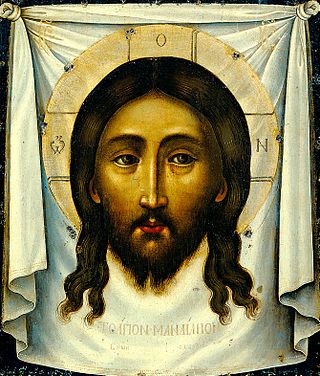
Acheiropoieta — also called icons made without hands — are Christian icons which are said to have come into existence miraculously; not created by a human. Invariably these are images of Jesus or the Virgin Mary. The most notable examples that are credited by tradition among the faithful are, in the Eastern church, the Mandylion, also known as the Image of Edessa, and the Hodegetria, and several Russian icons, and in the West the Shroud of Turin, Veil of Veronica, Our Lady of Guadalupe, and the Manoppello Image. The term is also used of icons that are only regarded as normal human copies of a miraculously created original archetype.
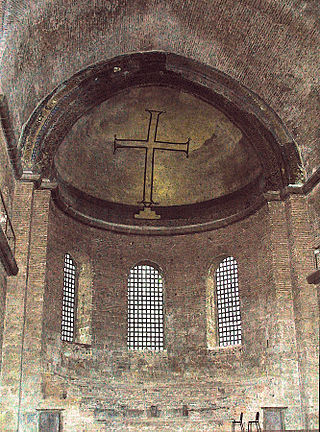
The Byzantine Iconoclasm were two periods in the history of the Byzantine Empire when the use of religious images or icons was opposed by religious and imperial authorities within the Ecumenical Patriarchate and the temporal imperial hierarchy. The First Iconoclasm, as it is sometimes called, occurred between about 726 and 787, while the Second Iconoclasm occurred between 814 and 842. According to the traditional view, Byzantine Iconoclasm was started by a ban on religious images promulgated by the Byzantine Emperor Leo III the Isaurian, and continued under his successors. It was accompanied by widespread destruction of religious images and persecution of supporters of the veneration of images. The Papacy remained firmly in support of the use of religious images throughout the period, and the whole episode widened the growing divergence between the Byzantine and Carolingian traditions in what was still a unified European Church, as well as facilitating the reduction or removal of Byzantine political control over parts of the Italian Peninsula.

Theophanis Strelitzas, also known as Theophanes the Cretan or Theophanes Bathas was a Greek painter of icons and frescos in the style of the Cretan School. He passed much of his career as a member of the monastic community of Mount Athos.

Agros is a village built on the Troödos Mountains, in the region of Pitsilia, in southwest Cyprus, which has built amphitheatrically among high mountains at an altitude of 1100 metres with a population of approximately 1,000. Agros is one of the most interesting villages of Cyprus and the Pitsilia area. The village is located 45 minutes away from the cities of Nicosia and Limassol, 20 minutes from Troodos Square and 80 minutes from the international airports of Larnaca and Paphos.
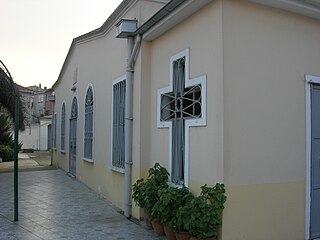
The Church of Saint Mary of Blachernae is an Eastern Orthodox church in Mustafa Paşa Bostanı Sokak in Ayvansaray in the Fatih district of Istanbul, just inside the old walled city. During the latter part of the Byzantine period, the original church complex on the site was one of the most important sanctuaries of Byzantium, arguably outstripping Hagia Sophia in importance due to its proximity to the Palace of the Blachernae. The Byzantine church complex was destroyed in 1434, and in the nineteenth century a small new church was built on the site. Today it is protected by a high wall, and fronted by a garden.
Anafotia is a village located in the Larnaca District of Cyprus, west of Larnaca. In 1994, the official name of the village became Anafotida (Aναφωτίδα), following a decision by the then-government of Cyprus to make the names of villages on the island more Greek. However, locally the village is still referred to as Anafotia.
Delikipos is a village in the Larnaca District of Cyprus, located 4 km west of Kornos.

Kouka is a small village in the Limassol District of Cyprus, in the foothills of the Troodos Mountains on the western slopes of the Kouris Valley. The village is 2 km south of Pera Pedi on the road to Sylikou, and it is home to the church of Timios Stavros.
Patapios of Thebes is the patron saint of dropsy. Saint Patapios’ memory is celebrated on 8 December and also at the Tuesday 2 days after the Sunday of Easter. His relic is kept at the female monastery of Saint Patapios at Loutraki, a spa town near Athens, Greece.
Like most communities of the Armenian Diaspora, the Armenian-Cypriot community is predominantly Armenian Apostolic. Some 5% belong either to the Armenian Evangelical Church, the Armenian Catholic Church, the Latin Church, the Greek Orthodox Church, the Anglican Church, the Plymouth Brethren Church, the Seventh-day Adventist Church or they are Jehovah's Witnesses; of this 5%, historically the most significant groups have been Armenian Evangelicals, who in the 1940s and 1950s comprised about 10% of the Armenian-Cypriot community, and Armenian-Catholics, who have been on the island since the time of the Crusades.
This is a timeline of the presence of Eastern Orthodoxy in Greece from 717 to 1204. The history of Greece traditionally encompasses the study of the Greek people, the areas they ruled historically, as well as the territory now composing the modern state of Greece.
Father Kallinikos Stavrovouniotis, birth name Kostas P. Mammous, the icon painter, was an Orthodox monk, ascetic in Cyprus, and was one of the most important Byzantine icon painters of the modern age.